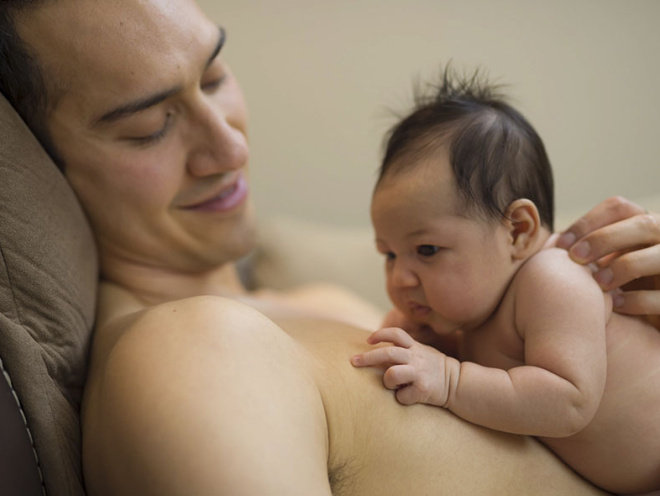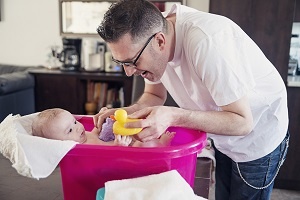Kangaroo care is a way of giving babies, especially those born early, all the benefits of skin-to-skin contact. But how might kangaroo care help you and your baby?
What is kangaroo care?
It gained the name because of the way kangaroos keep their babies (joeys) in their pouch. It actually means giving uninterrupted skin-to-skin contact to your baby. It can also include exclusively breastfeeding if this is possible. Some call it kangaroo mother care (KMC) but in fact both parents can do it.
"Kangaroo care is a powerful yet easy way to help your baby to stay healthy and well whether they were born preterm or full-term (WHO, 2003)."
It’s also thought to decrease neonatal mortality and help small babies to be discharged from hospital early (Richardson, 1997; WHO, 2003).
When do I start kangaroo care?
You’d usually start kangaroo care in hospital then continue it at home. It’s done by carrying your baby close to you, usually on your chest.
Kangaroo care is most often used for premature babies, although not those who are very premature (Tommy’s, 2017). It’s good for premature babies when they no longer have any medical problems and all they need is to feed and grow (Tommy’s, 2017). It’s a kind of alternative to an incubator.
If you’re interested, ask the medical staff what their policy is on kangaroo care. Some baby units might not be willing to offer it if it’s not familiar to them. But if the staff have experience with kangaroo care, they will be happy for parents to use it from around 28 to 30 weeks (Tommy’s, 2017). Parents usually practice kangaroo care until their baby reaches full term (40 weeks) (Tommy’s, 2017).
What are the benefits of kangaroo care and skin-to-skin contact for my baby?
Mentally
Kangaroo care will calm and relax your baby. Just being close to your chest will comfort them thanks to things like the reassuring rhythm of your heartbeat (Ludington et al, 2005; UNICEF UK, 2018). Kangaroo care also decreases arousal in babies, which can mean they spend more time in a deep sleep (Richardson, 1997; Jefferies, 2012).
Babies are more alert for longer periods with kangaroo care too (Richardson, 1997). And it’s linked with rapid brain development (Richardson, 1997).
Feeding
Kangaroo care is thought to be associated with breastfeeding for longer, producing more milk and being more likely to exclusively breastfeed (UNICEF UK, 2018). It can also help your baby to gain weight (Richardson, 1997; UNICEF UK, 2018).
Comfort
Kangaroo care can help your baby to keep warm too by regulating their temperature (Jefferies, 2012). This skin-to-skin contact releases oxytocin, which is a pain reliever for you and your baby (Johnston et al, 2014). That’s why babies given kangaroo care can experience less pain and cry less than those who are in incubators (Kostandy et al, 2008).
Physically
Kangaroo care can help babies to regulate their heart and breathing rates (Jefferies, 2012).
What are the benefits of kangaroo care and skin-to-skin contact for me?
Mentally
Kangaroo care can calm and relax you, generally improving your mental wellbeing. It’ll also help to reduce the chance of you getting postnatal depression or ease it if you already have it. This is thanks to your friend, the love hormone oxytocin (Dombrowski et al, 2001; UNICEF UK, 2018).
Kangaroo care can also help you feel like you are actively helping your premature baby. It can help you feel in control, giving you confidence and a sense of your role as a mother (WHO, 2003; Richardson, 1997). It can also help with bonding and help you to feel closer to your baby (Richardson, 1997; Jefferies, 2012).
Feeding
Kangaroo care makes breastfeeding easier and aids milk production. (Though of course, if your baby is not feeding enough or needs supplementing, there is nothing wrong with using formula as well as or instead of breast milk.) This will only be the case from around 32 weeks as until then the baby will probably be tube fed. Syringes or cups can be used too.
Practicalities
Using kangaroo care means your baby is more likely to be able to go home with you sooner (WHO, 2003; UNICEF UK, 2018). Hoorah for that.
What do you need for kangaroo care?
The only real ‘equipment’ you need is a support bind to keep your baby next to your skin. It’s usually a soft piece of fabric, about a metre squared, folded diagonally in two and secured with a knot or tucked in your armpit.
If you’re at home or in hospital, you won’t need the fabric as your baby will just rest on your chest (for women, between the breasts). See here for a more details and pictures of how to practice kangaroo care.
When the temperature is 22°C to 24°C, you can carry your baby naked except for a nappy, a cosy hat and socks. When it falls below 22°C, you could pop your baby into a sleeveless cotton top that you can leave open at the front to allow you to snuggle them skin-to-skin. You can cover them in a blanket if you’re in hospital or at home. Otherwise, you could wrap your own clothes around them (WHO, 2003).
It’s possible you might need other equipment, for example if your baby is premature. Equipment you might need includes:
- Neonatal scales with 10g intervals.
- A thermometer for measuring body temperature.
- Basic resuscitation equipment and oxygen – this should be available where possible for preterm babies.
- Drugs for preventing and treating the problems preterm babies frequently experience.
(WHO, 2003)
Your baby will only need to come off your chest for nappy changes and any medical assessment they might need. They can even sleep there if they are strapped to you but get guidance on this if you choose to do it.
How do you know whether kangaroo care is right for you?
- If you are available to do it and be with your baby full time.
- If you’re healthy enough yourself.
- If it’s something you want to do.
- If you have a support network around you to do other things like housework, as giving kangaroo care means you will be able to do very little else.
This page was last reviewed in September 2018.
Further information
Our support line offers practical and emotional support with feeding your baby and general enquiries for parents, members and volunteers: 0300 330 0700.
Attending a Baby Cafe or other breastfeeding support drop-in is often helpful.
You might find attending one of our NCT New Baby courses helpful as they give you the opportunity to explore different approaches to important parenting issues with a qualified group leader and other new parents in your area.
Dombrowski MA, Anderson GC, Santori C, Burkhammer M. (2001) Kangaroo (skin-to-skin) care with a postpartum woman who felt depressed. MCN Am J Matern Child Nurs. 26 (4):214-216. Available at: https://www.ncbi.nlm.nih.gov/pubmed/11452667 [Accessed 24th September 2018].
Engler AJ, Cusson RM, Bahnsen M, Coates P, McHargue L, Settle M. (2002) Kangaroo care: national survey of practice, knowledge, barriers and perceptions. MCN Am J Matern Child Nurs. 27(3):146-153. Available at: https://www.ncbi.nlm.nih.gov/pubmed/12015442 [Accessed 24th September 2018].
Jefferies AL; Canadian Paediatric Society; Fetus and Newborn Committee. (2012) Kangaroo care for the preterm infant and family. 17(3):141-143. Available at: https://www.ncbi.nlm.nih.gov/pmc/articles/PMC3287094/ [Accessed 24th September 2018].
Johnston C, Campbell Y, Disher T, Benoit B, Fernandes A, Streiner D, Inglis D, Zee R. (2017) Skin-to-skin care for procedural pain in neonates. Cochrane Database Syst Rev. (2):CD008435. Available at: https://www.cochranelibrary.com/cdsr/doi/10.1002/14651858.CD008435.pub3… [Accessed 24th September 2018].
Kostandy R, Cong X, Abouelfettoh A, Bronson C, Stankus A, Ludington SM. (2008) Effect of kangaroo care (skin contact) on crying response to pain in preterm neonates. Pain Manag Nurs . 9(2):55-65. Available at: https://www.ncbi.nlm.nih.gov/pmc/articles/PMC2647362/ [Accessed 24th September 2018].
Ludington-Hoe S, Hosseini R, Torowicz D. (2005) Skin-to-skin contact (kangaroo care) analgesia for preterm infant heel stick. AACN Clin Issues. 16(3):373-87. Available at: https://www.ncbi.nlm.nih.gov/pmc/articles/PMC1890009/ [Accessed 24th September 2018].
Richardson H. (1997) Kangaroo care: why does it work? Midwifery Today. 44. Available at: https://midwiferytoday.com/mt-articles/kangaroo-care-work/ [Accessed 24th September 2018].
Tommy’s. (2017) Kangaroo care. Available at: https://www.tommys.org/pregnancy-information/pregnancy-complications/premature-birth/your-babys-time-hospital/kangaroo-care [Accessed 24th September 2018].
UNICEF UK. (2018) The baby friendly initiative. Skin-to-skin contact. Available at: https://www.unicef.org.uk/babyfriendly/baby-friendly-resources/implementing-standards-resources/skin-to-skin-contact/ [Accessed 24th September 2018].
WHO. (2003) Kangaroo mother care: a practical guide. Available at: http://www.who.int/maternal_child_adolescent/documents/9241590351/en/ [Accessed 24th September 2018].






